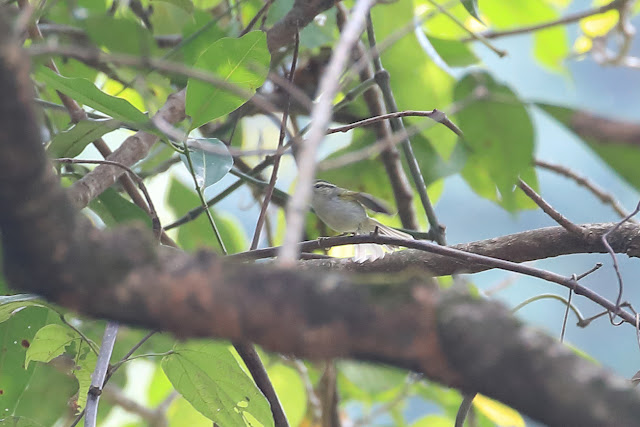I put it into unidentified species because the record committee in Hong Kong first said that there is still no reliable published source for safely identifying from forkiensis and other Blyth's complex by morphological or vocal differences, However, after studying and consulting different birders (thanks to all!) the majority agreed that this is a very good candidate for Claudia's Leaf Warbler (except 12 - the rich girl from Shenzhen/Yunnan/NE China👻, she suggested this may be Blyth's Leaf Warbler) and so I better retick this one on my lifer list.
Of course, the ultimate identity is not 100% certain until we got any DNA sample of the bird, more comments are very welcome and I may even untick this reticked bird!
General speaking the appearance can be always affected by lighting and angle. I would say the long and elongated structure of this bird, including long bill and tail, non-rounded head rule out White-tailed/Kloss's complex, which would give a Pallas's Leaf Warbler jizz. To me, this photo also rules out Blyth's Leaf Warbler (the call is very very similar to my ears) as photos of Blyth's online always show rounder head with more compact jizz (similar to White-tailed/Kloss's complex more than Hartert's/Claudia's), brighter upperparts, more contrasting wingbars and head pattern, with brighter yellow supercilium (stronger in front) as in https://www.hbw.com/ibc/photo/blyths-leaf-warbler-phylloscopus-reguloides/perched-adult taken in India. Somehow the lore and eyestripe seems to be darker in Blyth's. In Hartert's, I would expect the supercilium is long and yellowish, not showing a distinctive two-toned color in Blyth's or Claudia. Race goodsoni has very yellowish underparts and sometimes confused with Sulphur-breasted Warbler (https://macaulaylibrary.org/asset/128652221) while race fokiensis can be a problem, but still seems to have more yellowish cheek and upper throat (http://birdingpage.blogspot.com/2016/02/kinmen-2016.html). Also from my observation on behavior and photos online, I would guess that Hartert's climbs thick trunk most often, then Claudia, and Blyth's the least, while White-tailed/Kloss's very very rare to do so.
very distinct crown pattern, more contrasting comparing Kloss's Leaf Warbler. The central crownstripe is very broad and pale greenish, becoming whiter on nape.
P.S. the greyish lower nape and upper mantle is another feature for Claudia's as Jonathan suggested
rather long in structure, lack the neckless jizz comparing the White-tailed/Kloss's complex, or sometime the Blyth's Leaf Warbler.
structure is long and elongated, especially the bill, head and tail, separated from White-tailed/Kloss's complex.
feeding on vertical branch or tree trunk is seldom reported in White-tailed/Kloss's complex, more commoner in Blyth's complex. For the underpart like this, I would expect Blyth's shows much more cleaner white below. ID from forkiensis is always tricky.
again feeding on a vertical branch, the supercilium is rather duller comparing Blyth's and Hartert's.
leg color and bright orange lower mandible cannot help in this case, only separating from normally seen Yellow-browed or Pallas's Leaf Warbler. The thicker double wingbars and lack of solid yellow vent and undertail coverts help ruling out Eastern Crowned Warbler
I am not so sure whether this bird can 100% identify the playback or not, but it was super reactive whenever I played the Claudia's playback, following everywhere with my speaker.
After playing-and-reacting for awhile it started to call and sing which raised the topic here. I encountered similar experience before, like the Hume's Leaf Warbler.
undertail pattern maybe useful in separating these Phylloscopus complex, however, there is still variation and different angle and lighting leads to different perception. As described by Ayuwat in here (https://ayuwat.wordpress.com/2013/10/13/blythsclaudiasdavisons-part-1/) and here (https://ayuwat.wordpress.com/2013/10/14/blythsclaudiasdavisons-part-2/), and the wonderful comparison here (https://ayuwat.files.wordpress.com/2015/08/phylloscopus012.jpg), the Shek Kong individual fits much better in Claudia's as thicker white fringes than Hartert's while narrower than Blyth's.
another angle which shows the undertail while the bird was singing. Blyth's, White-tailed (Davison's) or Kloss's would show much more white.
This is a reference from HBW Alive showing the undertail pattern of Claudia's Leaf Warbler. Again, there is much variation in field and sadly HBW didn't describe the other undertail pattern.
one more photo showing the less yellowish supercilium. And also the whitish throat and underparts.
when it is not calling or singing, it is really difficult to be identified, that's why we may in fact overlook this species many many times in Hong Kong, which should be in theory a regular passage migrant or winter visitor.
another interesting behavior is wing-flicking, very hard to get a clear shot. As in eBird and HBW, this species regularly flicks its wings one after the other.
as the bird was still in its wintering range, we cannot see full display like this in Beijing: https://twitter.com/birdingbeijing/status/1003488141875937282
flick its right wing first then left.Maybe the flicking order is a feature to tell, who knows.....
Call and song sometimes are key identification features so I recorded after the playback. I think the call and song can rule out Hartert's Leaf Warbler while still similar to the Blyth's. I uploaded the best recordings and generate the sonogram. The call is exactly the same as https://www.xeno-canto.org/457443 and https://www.xeno-canto.org/414471 and https://macaulaylibrary.org/asset/103188391#_ga=2.95355732.910028238.1582600043-1471056763.1582600043; song is also compared with https://www.xeno-canto.org/209845 and https://www.xeno-canto.org/111047 ; the Shek Kong bird's recording is very similar and probably the individual was singing sub-song as Ayuwat in Thailand commented. Again, this individual was super hyper and reactive to my Claudia's playback, allowing good views so likely to be sufficient evidence to claim the bird as Steve suggested. I don't know will Claudia's and Blyth's mix up even they are geologically separated (?) in theory.
Call
Song
Call and song
song, one more recorded on 24 Jan, more likely a subsong of Claudia's Leaf Warbler. The repeated notes can be comparing with Blyth's (https://www.xeno-canto.org/470153)
Anyway, ticking is not important while studying more is the most enjoyable part behind the field.
Reference:
del Hoyo, J., Collar, N. & Christie, D.A. (2020). Claudia's Leaf-warbler (Phylloscopus claudiae). In: del Hoyo, J., Elliott, A., Sargatal, J., Christie, D.A. & de Juana, E. (eds.). Handbook of the Birds of the World Alive. Lynx Edicions, Barcelona. (retrieved from https://www.hbw.com/node/1343937 on 25 February 2020).





















沒有留言:
張貼留言